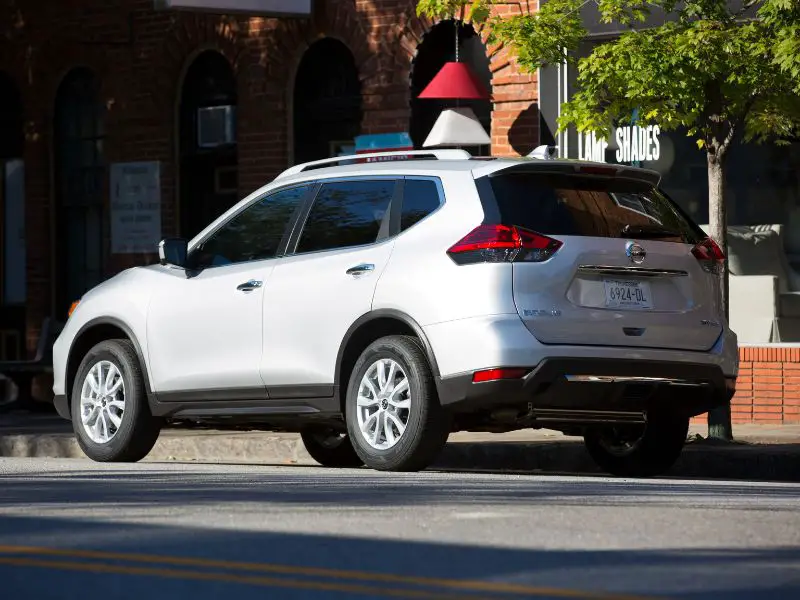While Nissan is also known for good quality cars, some models, like the Nissan Rogue, have some known problems.
The Nissan Rogue suffers from CVT automatic transmission failure, paint peeling, HVAC issues, an Infotainment system with a mind of its own, noises emitting from the front of the vehicle, and unintended braking.
To help you make a more informed decision, we’ve broken down these issues below and looked at some Nissan Rogue recalls you need to be aware of (especially if you have one of these models).

6 Common Nissan Rogue Problems
1. CVT Automatic Transmission Failure
At around 125,000 miles (201,168 kilometers), Nissan Rogues can start developing serious transmission problems with the CVT automatic models from 2008 to 2016.
The main issue was a lack of an oil cooler for the transmission, resulting in the transmission cooking the automatic transmission fluid and thus losing all lubricating benefits.
This usually happens when driving at higher speeds for a long time, driving the car with an ambient temperature higher than 96 degrees Fahrenheit (33 celsius), and climbing a steep or extended hill for 6 miles (9.6 kilometers) or longer.
Here’s the service bulletin from Nissan about this issue.
Some owners new replacement CVT transmission only held 18,000 miles (28,968 kilometers) before failing again.
A new transmission will set you back between $4,000 to $4,600, and rebuilding the old transmission will be between $2,800 to $3,000.
2. Paint Peeling Off
The 2013 and 2014 Nissan Rogues sold with pearl white paint had an issue where the paint would bubble up and peel off at around 37,000 miles (59,545 kilometers).
This is a problem with the primer used on the Rogue because when the paint starts peeling off, you are left with the exposed galvanized body panel, almost the exact same issue as the Ford Escape had.
Getting this repaired can set you back anywhere from $150 to $3,500.
3. HVAC Not Working Properly
Owners of the 2014 to 2016 Nissan Rogue started feeling around 30,000 miles (48,280 kilometers) that the HVAC (Heating, Ventilation, and Air Conditioning) wasn’t working as it was supposed to.
When they drove for over an hour in warm weather, it was noticeable that the cold air from the vents would slowly rise to ambient temperature.
What was happening is the air conditioning condenser could not cope with cooling for long durations of time and froze inside and out, resulting in no circulation of the air conditioning gas.
In cold weather situations, owners noticed the opposite; the vehicle will give off heat for a short while.
Then the air out of the vents will slowly go to ambient temperature.
The fix is an improved HVAC, but it costs around $2,000 because a technician must remove the entire dashboard assembly to replace it.
4. Infotainment System Malfunction
This problem plagued the 2014 Nissan Rogue, where the infotainment system would stop working and reboots itself.
Since the infotainment system integrates many features, these features won’t work or are not as intended.
This ranges from the reverse camera not displaying, connectivity issues to phones, the radio not working, and the navigation not correctly functioning.
The fix was an update Nissan rolled out in 2014, but in the beginning, many owners had their head units replaced, but it was not the issue.
5. Front Strut Bearing Defect
Shockingly, Nissan overlooked this issue on the Rogue while it was being moved around at dealers.
Some owners heard popping and clunking noises at the delivery of their new Rogue.
In contrast, others ignored it and got so bad that they took it to be repaired at around 7,000 miles (11,265 kilometers).
The issue was that the front strut bearing had a defect that would bind while steering, not so substantial that it affected steering but enough to result in the popping and clunking sounds, but it could later result in total bearing failure.
6. Unintended Braking
In the later models of the Rogue, Nissan installed a collision warning system and automatic braking to prevent rear-end crashes and pedestrian crashes.
The system was over-sensitive and falsely identified risks that, in many cases, weren’t even there, resulting in the vehicle doing an emergency braking procedure.
You can imagine what a shock you will have when your vehicle out of the blue stops and the risks that it can make for being rear-ended by someone else.
Recalls on the Nissan Rogue
While recalls fix vehicle issues, there is still a chance that some cars never got fixed.
Either the owner did everything DIY, or took it to a private mechanic who never knew about the recalls.
So it is advantageous for you as a potential buyer or owner of a Nissan Rogue to learn about these recalls.
And if you already own a Nissan Rogue, take your vehicle to a dedicated Nissan dealer as soon as possible to rectify these problems.
2008 Recalls
- 2008 model-year vehicles equipped with Continental Automotive systems OCS (Occupant Classification Systems) may have a resistor in the passenger seat that is manufactured out of specification.
This can result in an interruption between the OCS and the ACU (Airbag Control Unit).
2009 Recalls
- 2008 to 2009 model year vehicles sold in or registered in the states that use salt on the roads may have a nut used to secure the transmitter for the TPMS (Tire Pressure Monitoring System) that can rust, resulting in the tire losing air.
- 2008 to 2009 model-year vehicles have a screw in the steering gear housing cover that can become loose and fall out.
As it loosens, the steering response will worsen until the screw falls out, and the vehicle driver gives considerable input; it can cause the pinion shaft to come out, resulting in total steering loss.
2010 Recalls
- 2008 to 2010 model-year vehicles equipped with Garmin Nuvi 750 Model navigation systems batteries in the GPS can overheat and result in a fire.
2011 Recalls
- 2010 to 2011 model-year vehicles with EPS (Electronic Power Steering) may have a circuit board installed incorrectly, causing unwanted stress on the solder of the circuit board that can result in the solder cracking and separating from the board, causing the EPS to stop working.
2012 Recalls
- 2012 model-year vehicles, during assembly, the TPMS (Tire Pressure Monitoring System) was not activated, resulting in the cars failing to comply with requirements of the Federal Motor Vehicle Safety Standard.
2014 Recalls
- 2014 model-year vehicles may be installed with the wrong bolt to connect the upper steering assembly to the intermediate shaft; this can result in the bolts loosening and falling out and the driver losing control of the vehicle.
- 2014 model-year vehicles may have one lug nut on the right side wheels that were not correctly tightened.
2015 Recalls
- 2014 to 2015 model-year vehicles may have front wheel hub assembly fasteners that were not appropriately torqued during the assembly process; this can result in the brake caliper separating from the wheel assembly.
- 2008 to 2014 model-year vehicles are experiencing an electrical short at a connector near the driver-side floor where snow/water and salt seep through and land on the connector, resulting in an electrical fire.
- 2014 model-year vehicles have improper nickel plating on the inside of the fuel pump that can cause the fuel pump to fail and result in the car stalling.
- 2015 model-year vehicles equipped with 17-inch wheels have incorrect tire size information on the tire labels, thus not complying with the FMVSS (Federal Motor Vehicle Safety Standard) requirements.
- 2015 model-year vehicles, the driver-side front, and rear doors may not latch properly, which can result in the door opening while driving.
- 2015 model-year vehicles have a problem with the shift selector knob where you can move it out of park without depressing the brake, thus failing to comply with the requirements of the FMVSS (Federal Motor Vehicle Safety Standard).
2016 Recalls
- 2014 to 2016 model-year vehicles’ rear lift gate supports may corrode due to poor anti-corrosion treatment resulting in the stays releasing pressure suddenly or breaking.
- 2014 to 2016 model-year vehicles have an OCS (Occupant Classification System) on the passenger front seat that can incorrectly identify an adult as a child or an empty seat, resulting in the airbag not deploying as intended.
2017 Recalls
- 2016 to 2017 model-year vehicles have improper welds on the recliner joints on the lower seat frame of the rear seats that do not comply with the requirements of the FMVSS (Federal Motor Vehicle Safety Standards).
- 2016 model-year vehicles’ front passenger seat frames may have improper welds that do not comply with the FMVSS requirements.
2019 Recalls
- 2018 to 2019 model-year vehicles, the driver can adjust the rear camera so that it is not visible on the infotainment system and will retain that setting, thus failing to comply with the FMVSS requirements.
2021 Recalls
- 2021 model-year vehicles may have a fuel hose that is not appropriately secured, and the fuel tank lock ring may not be fully seated, resulting in the fuel hose leaking resulting in a risk of fire and the fuel tank emptying itself.
- 2021 model-year vehicles may have been installed with the wrong wheel nuts that can loosen and cause wheel vibration and even wheel separation from the car.
- 2021 model-year vehicles may have an internal bushing missing in the left and right rear brake caliper, allowing the O-ring seal to move and brake fluid to leak, resulting in a loss of braking performance.
- 2021 model-year vehicles may have improper welds on the second-row upper tether wires in the seatback frame, preventing the anchoring of a child seat securely.
- 2017 to 2019 model-year Hybrid vehicles have a bracket of the ECM (Electronic Control Module) that can damage the engine harness, resulting in a blown fuse and causing the engine to stall.
- 2021 model-year vehicles have abnormal wear inside the fuel pump that causes it to overheat and fail to cause the engine to stall.
2022 Recalls
- 2014 to 2016 model-year vehicles are experiencing an electrical short at a connector near the driver-side floor where snow/water and salt seep through and land on the connector, resulting in an electrical fire.
- 2022 model-year vehicles have a manufacturing error where the bottom of the fuel tank may be too thin, resulting in road debris puncturing the tank causing a fuel leak and potential fire hazard.
- 2021 to 2022 model-year vehicles, when the Sirius XM subscription is set to “Not Subscribed,” it can cause the infotainment system to reboot, causing the rearview camera not to function, resulting in it failing to comply with the FMVSS.
- 2017 to 2019 model-year hybrid vehicles have a hydraulic brake booster assembly that can potentially overheat, causing a loss of brake performance.
- 2022 model-year vehicles’ fuel tanks may have been punctured when Nissan performed vehicle modifications.
- For 2021 to 2022 model-year vehicles, the rear safety belts may not retract properly, making it difficult to operate and prevent their usage.

Final Thoughts On Nissan Rogue Problems
With the CVT automatic transmission, paint peeling off, the HVAC system not working, the Infotainment system resetting itself, front struts bearings making noise, and the automated emergency braking system being over sensitive, the Nissan Rogue has its fair share of faults.
The best thing to do if you own a Nissan Rogue is to take it to a Nissan dealership and have them check for any recalls that haven’t been completed.
If you are in the market for a used Nissan Rogue, get a full vehicle history report and avoid any models with an outstanding recall.
Hopefully, you found this article helpful, and you can go to your next Nissan Rogue test drive knowing what to look out for.
FAQs
Is The Nissan Rogue A Reliable Car?
Yes, with an average maintenance cost of around $467 per year, the Nissan Rogue is well under the average compared to other compact SUVs, which average about $521.
Only the models from 2008 to 2016 fitted with the CVT automatic transmissions needed to up their reliability.
Does Nissan Rogue Have Transmission Problems?
Yes, models between 2008 and 2016 fitted with the CVT automatic transmissions had many issues until the dealers fitted them with gearbox oil coolers.
How Long Do Nissan Rogue Transmissions Last?
On average, the transmissions last 125,000 miles (201,168 kilometers), but some owners reported as low as 18,000 miles (28,968 kilometers).
After the gearbox oil coolers were installed, the vehicles seemed to have no issues since the problem was the transmission fluid boiling.
